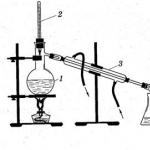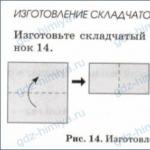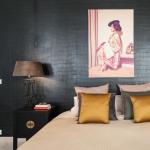Columns in the house have always been considered a sign of wealth and greatness. This is a piece of decor that has 2 purposes at the same time: functional (to support some parts of the building) and decorative. Functional can only be very strong concrete columns, which are now practically not built in residential buildings. But it is quite possible to make decorative columns with your own hands. And ordinary foam will come to the rescue here.
Columns in the house have always been considered and are considered a sign of wealth and greatness.
Do not be surprised that it was polystyrene that was chosen for work. Firstly, due to the fact that the material will eventually be completely embedded, it will not be able to harm health and will perfectly retain its shape. And secondly, it is extremely easy and pleasant to work with him due to the fact that he weighs little.
Preparation of tools and materials
Styrofoam is an inexpensive material with which it is quite easy and cheap to build almost any element. This is a fairly durable material that can be used both indoors and outdoors. Consider one of the many options for how to make such columns yourself. For this you will need the following materials:

Styrofoam is an inexpensive material with which you can easily and cheaply build almost any element.
- facade putty;
- construction knife;
- plaster corner;
- pencil;
- roulette;
- plaster mesh;
- putty knife;
- paint and brush for her;
- soft cloth;
- fine-grained sandpaper;
- glue for mounting tiles;
- polystyrene foam (depending on the size of the proposed columns, fine-grained or coarse-grained material is selected).
Back to index
Marking and preparation of foam
Consider the option of building and installing foam columns on the walls. As a rule, this is appropriate both in the house and in the apartment. It will look especially good in the living room, where relatives and friends always gather. Visually, this will enlarge the room and decorate it very much.
First you need to make markings on the walls in order to clearly know where the columns will be located, how many pieces they need and how thick they should be. Marking is carried out with a pencil and tape measure. At the same time, it is still desirable to use a plumb line and level, so as not to eventually mount the column crookedly.

Possible types of columns for doing it yourself.
Now proceed to work directly with the foam. It is important to take into account the fact that the width of the column should not be greater than the width of the foam sheet. Only in this way will the decorative element turn out to be of high quality and durable. The outcome of this, we measure the foam, draw a line and cut off half of its width from the sheet. This must be done very carefully in order to maintain the correctness of the line along the entire length, not only along the edge, but also in the depth of the sheet itself.
Now the prepared halves of the foam sheets need to be adjusted in height. As a result, at the output you should get the required number of strips, the height of which is equal to the height of the columns, respectively, the width should also be selected.
Back to index
Installation of the column and additional props
After that, you need to stir the tile adhesive and apply it with a spatula to the inside of the column, and then immediately press it in the intended place against the wall. In this case, it is desirable to work together in order to press the column at once in several places at the same time.
So gradually all the columns are attached. If the ceilings in the room are too high, then the column is assembled from parts. At the same time, it is extremely important to join these parts well so that the joints are not visible in the future. To do this, coat the edges of the joints with glue.

Supports for a foam column will not carry any functionality, but will act as an exclusively decorative element of the column.
Now is the time to start decorating the column. First, it is advisable to equip visual props. In this case, they will not carry any functionality, but will act as an exclusively decorative element of the column. We will equip the supports along the top and bottom of the column. In this case, you need to mount them perpendicular to the column itself in a circle so that they envelop it. To do this, pieces of the desired width are cut out of the foam and glued to the lower and upper parts. So the feeling will remain that the entire ceiling is supported on this column, since the simplest support is very similar to a ceiling plinth.
Back to index
Leveling, puttying and grouting
But still, the column, although mounted, does not look quite presentable. Therefore, you will have to work a little more on her appearance to make her look truly expensive. First you need to correctly arrange all the corners with visible defects. And here a plastering corner for finishing work will come to your aid. In those places where the corners of the foam are uneven or damaged, you just need to stick such corners of a certain size. They are glued to the same tile adhesive, but you can use ordinary wood glue. During operation, make sure that the glue does not dry out on the front parts of the foam, otherwise the subsequent decoration will not be perfect.

To make the column look natural, all flaws are puttied after its installation.
Next, we move on to the process of applying putty. It is applied in 2 main layers. The 1st layer will be the base layer, and the 2nd layer will be the final one, which determines the very degree of surface smoothness. This two-level treatment will provide better adhesion to the material and maximum smoothness.
First you need to put the thinnest plaster mesh on the column, and then apply the 1st putty layer. This layer should be such that the mesh is only fixed on the surface, and not completely invisible under the putty layer. This is how the column is finished absolutely over its entire area, including visual supports.
When the 1st layer dries, you can take on the 2nd one. The 2nd layer must be applied especially carefully. Please note that the putty layer itself should also be thin. But at the same time, in the end, it must hide behind itself all the defects, irregularities and finishing materials available on top (mesh and plaster corners). So, after the putty dries, a smooth white surface should form, which does not have visible defects.
Now, when the putty is completely dry, it is necessary to lightly grout the surface of the column. To do this, use fine-grained sandpaper. Only during work you do not need to get carried away much, since this grout is made for preventive purposes in order to remove very small flaws. Finally, dust off the columns with a dry cloth.
Arches with columns - characteristic of ancient architecture.
Arches with columns are architectural elements that were used in construction long before our era. The peoples of antiquity used these elements in the construction of temples, palaces, bridges, viaducts. Arches, which are a curvilinear ceiling between supports or a wall opening, were found in the architecture of Ancient Rome and the Ancient East. This element was designed to redistribute the ceiling load (thrust), reducing the vertical reaction of the supports, which exerts pressure on the foundation. The higher the rise of the arch, the smaller its thrust. Consider the use of this element in the architecture of different historical periods. If the architects of Ancient Egypt and Greece created horizontal lintels, then the ancient Romans, who borrowed the arch system from the Etruscans, began to combine arches with columns, creating semicircular lintels. Arched structures combined with columns were a characteristic element of ancient Roman architecture. Arcades became popular: rows of arches that rest on columns. Thus, open galleries, multi-tiered bridges, amphitheaters were built.

Roman arcade.
An example is the Colosseum - a three-tiered arched structure Arched ceiling became the main element of the triumphal Roman arches. Reducing the horizontal thrust was achieved by relying on walls or buttresses. Arched bridges, aqueducts relied on fortified banks. The Romans used mainly semi-circular structures, later architects, creating places of worship and palaces, used new forms of arches: lancet, keeled, multi-layered, horseshoe-shaped and others. Semicircular arches In the semicircular arches used in ancient Rome, the arc is described by a semicircle. The decor of the arch in the photo shows a semicircular design.

Semicircular arches in Roman architecture.
horseshoe arches
Horseshoe arches were depicted in the manuscripts of the "Beatus of Lebana" by Magins, who worked on the construction of the monastery of San Miguel de Escalada, near Leonas. The monastery had elements of the Moorish style and was built by monks who arrived from Córdoba in 913 AD.
Horseshoe-shaped arches symbolized holiness in Islamic culture, such arches were used in the mosque of Cordoba (756-796), from here, according to some researchers, it spread to Spain by architects from Andalusia. This type of arch has an elevated center of construction. The horseshoe arch was used in the railway station in Liverpool and Manchester (designed by John Foster. 1830) This type of arch is present on the front gate of the Cheetham Hill synagogue in Manchester (1870) Elliptical arches The elliptical arch has the shape of an ellipse enclosed between two extreme points this figure. Elliptical ceiling and arch decor in the photo below.

Elliptical arch with decor.
pointed arches
In lancet arches, the pressure is concentrated in a narrow vertical area supported by a buttress. Decreased pressure on the foundation. This feature made it possible to lighten the walls and use arches on different floors. The lancet arch became the main element of the Gothic style. An example of the use of lancet arches is the abbey of Montecassino (1071), the Church of Cluny in 1088, Bolton Abbey (Britain. 12th century). Lancet arches were also used in the architecture of Egypt (Ibn-Tulun Mosque in Cairo). Lancet masonry and arch decor in the photo below.

Pointed arch.
Multi-bladed arches
The multi-bladed arch appeared on the windows of the al-Mutawakkil mosque (848 - 849 in Samarra), which were connected by five-bladed decorative forms of arches. Such an arch became popular in North Africa and Andalusia. Multi-blade arch from the 10th century. began to be used in Europe. Especially popular was the arch in the form of a shamrock - a symbol of the Trinity in Christianity.

The arch in the form of a trefoil is typical of the Gothic era.
Keeled arches
Late Gothic in the 16th century in the architecture of Venice, England, France, a keeled arch was used - a kind of lancet arch. The keeled arch was often used in the architecture of ancient India. Parabolic arches Parabolic arches have the greatest strength. Parabolic arches transfer the force of thrust to the supporting walls almost completely, and this ensures their strength. An example of a parabolic structure and a Gothic decor of the arch in the photo.

Parabolic arch in a gothic cathedral.
There are "blind" arches, they reinforce the walls.

The blind arch reinforces the wall above the actual arched ceilings.
In modern construction, arches are often not load-bearing elements and play only a decorative role, supporting the style of the facade or interior. Decorative arched structures are created from modern materials that are durable, resistant to moisture, easy to install, such as polyurethane. You can choose decorative arches from the photo in the booklet.

An arch with columns in the interior or in the design of the facade will help to give the building a certain historical look.
It was the 25th day of August, summer was coming to an end, and autumn still did not want to come later to the already cloudy St. Petersburg. Along with autumn, depression came up with a proud gait
To which we say: "Not today!" and we begin to decorate our rented apartment (where, in fact, there is a full “Pe” in terms of repairs). Naturally, I’m still a Jew, and my soul is not at all generous, so there will be maximum savings, trash and hardcore in the Tarantino style.
Let's go guys. Since no one is interested in wallpapering, I will skip this moment. And let's start doing, your mother, a COLUMN!
(backlight for showiness, usually turned off (from LED strip))
Let's start with the most unpleasant: let's go outside, or rather to a hardware store to buy. I stocked up in several stores, so I won’t advise a certain one, except for Leroy, and then because of the cheapness.
[Note!] If there is no car, it is better to lure your friend or girlfriend with something, or call a taxi (but this is an extra cost, so a friend is the best, he will help you later if he wants)
I immediately warn you that I don’t really understand construction, etc. So ardent masters of this business, forgive me for the fact that your eyes will bleed.
How to get hot: Let's go!
Ingredients for our dish:
Liquid nails – 1pc –
100r gun for him.
Profile decorative polystyrene, dl. 2m, 35x35mm (ceiling plinth and material closely similar to foam plastic) - 12 pcs - cost
Ceiling plate (without drawings) – 1 pc –
Double-sided tape - 1pc -
110r
Stenoflex 400 (take the largest one) - 1 pc -
Base for Pilaster – 3 pcs –
1800r - Yes, yes, here my Jew also rebelled, but this figure can be avoided if you put the column in the corner, you will need one piece there. I decided to go hardcore and put the column in the middle of the wall to make the rest of the wall as a workplace with a table and all sorts of mischief.
You can also put a column in the middle of the room, but then you will need as many as 4 pieces of these bases and 2-3 more plinths.
We need a construction knife with replaceable blades just in case, so let's add another 150r.
In total, I got: 2,520r + 160r for a shawarma in pita bread from an exquisite chef.
Let's start.
I didn't think to take the first photo, sorry :(
First, we measure the height of our Bases to the Pilasters, make a mark on the wall with a pencil.
We take our Stenoflex
DIY decorative column
Doing Together #1: Do-it-yourself column for a penny
How to make decorative columns with your own hands
Thinking through the interior of his living space (decorating a house or apartment), even a person far from design art often uses various options for additional techniques and architectural elements. A special majestic atmosphere is given to the room by the decoration of its interior space with columns. Do-it-yourself decorative columns can be made from many modern materials, for example, from foam.
Step-by-step instructions for making columns
Thanks to such interesting details, made, for example, in antique style, you can create a delightful classic interior. Naturally, such a direction in decorating a room can be entrusted to an experienced professional in this field, but not everyone can afford this option. Those who decide to turn their fantasy into reality on their own will come to the aid of an affordable and inexpensive material (styrofoam) and the following instructions.
So, at the very beginning, you should take care of the availability of all the building materials and tools necessary for the construction of columns. You will need:
- putty,
- putty knife,
- bag of tile adhesive
- Styrofoam,
- blade for cutting wood or metal
- plaster corner for finishing work,
- building level.
At the very beginning of work, you should decide on the exact location of future columns, their thickness and number.
If your room has high ceilings and a large spatial area, then you need polystyrene No. 5 for columns. Do-it-yourself decorative columns from such building materials are wide, thick and very reminiscent of antique columns. Using the readings of the building level, make all the necessary markings on the wall surface.
After marking, you should proceed to the direct preparation of polystyrene foam layers. It is advisable to measure the selected foam number as accurately as possible, carefully beat off the middle in it and mark it as a cut line. That is, the layers of material must be cut into two halves along the length. Cutting foam is best with a special blade designed for cutting wood or metal.
On the one hand, each half of the foam sheet must be lubricated with tile adhesive. Let him soak. This may take up to 10 minutes. After this time, the sheets should be carefully glued along the marking line. When gluing the foam, try not to put too much pressure on it, as this material is particularly fragile. Thus, lay out the entire column on the wall.
After sticking to the surface of all parts of the column, care should be taken that they have a base and a beginning. There is no need to buy special individual elements for these purposes, since it is quite possible to use the remnants of foam.
Having completed the basis of the entire structure, start adjusting it. In order for the decorative foam columns to have even corners, it is necessary to use the help of a plaster corner for finishing. With this corner you need to glue both corners of the column. And only after the corners have completely dried, you should start puttying work. Putty is applied in such a way that its first layer is thin and strengthens the structure of the entire part, fitting it. To do this, it is enough to use a special grid for plaster. After the first layer has dried, the second layer is applied.
The finished column remains only to be painted.
Decorative columns can also be built from other modern materials. For this work, polyurethane stucco molding is quite suitable. The advantages of such material include durability, strength and low cost.
In any case, we can say that the columns in the house from any available building material will enrich the atmosphere and give it a significant amount of seriousness and solemnity.
Do-it-yourself gypsum columns
Do-it-yourself plaster columns How to make decorative columns with your own hands Thinking through the interior of your living space (decorating a house or apartment), even far from design art
Until recently, columns in interiors served as load-bearing supports. Now, in most cases, these elements play a decorative role in the design. False columns have become an integral part of both classical and modern stylistic trends. In shape, they can be square, rectangular or round, triangular are less common. In addition to the main function - interior decoration, the column can serve as a decorative box for communications or the basis for a furniture structure, as well as a zonator for a fairly spacious room or decoration of arches. How to make a similar element of the interior with your own hands? Let's look at a simple example.
Do-it-yourself drywall column: preparatory stage
Any drywall construction requires a detailed drawing that will help determine its design and calculate the materials. For the right project, you need to know the diameter of the future structure, its shape and height. Another important step is the preparation of the necessary tool.
Namely:
- Drywall knife or electric jigsaw,
- Metal shears or grinder,
- Ladder,
- Square and tape measure,
- Ruler and pencil,
- Plumb and level
- Screwdriver, electric drill and puncher,
- Spatulas and construction mixer,
- roller,
- Compasses (in the case of a round product).
The arsenal of materials includes a metal profile, drywall sheets, fasteners, primer, sickle and putty. If you plan a column with external corners, you will need a perforated corner for their design.
How to make a drywall column: install the frame
The frame is the supporting structure of the entire product. It sets the shape of the future element of the interior, so the installation begins with its assembly. When the location of the future column has already been determined, the project has been drawn up and the surface has been prepared for work, you can proceed with the installation.
Lathing device in stages:
- An outline of the section of the column is applied to the ceiling, then, using a laser level or a plumb line and a pencil, the image is transferred to the floor. At this stage, special attention should be paid to the accuracy of the markup. Otherwise, you can ruin the entire repair.
- Further, corners are made from a metal profile and attached to the floor and ceiling with dowels along the marking contour. They will serve to fasten the racks. It is very important to fasten the elements clearly opposite each other so that the structure is even.
- A rack profile is taken and cut into vertical elements of the crate, according to the parameters of the drawing. The number of racks is determined by the weight of the material and the functional load of the column.
- Racks are attached to the corners with self-tapping screws.
- To strengthen the frame between the racks, jumpers are mounted horizontally and diagonally.
If the column serves as a box for hiding water pipes, it is better to lay soundproof material inside the frame.
Plasterboard sheathing
This stage may differ in the specifics of the installation of drywall and the preparation of the necessary elements. For example, in the case of a round column, the material will need to be bent according to the diameter of the structure. A rectangular or square column is simpler in this regard, however, there are some nuances.
Fixing drywall on the example of a square-shaped product:
- On the GKL sheets, the necessary elements are marked and the material is cut using a construction knife or a jigsaw.
- Parts of the skin are attached to the frame with the help of self-tapping screws. The distance between the fastening points should not exceed 15 - 20 cm. The self-tapping screws should be slightly recessed into the drywall.
At this stage, when screwing in the screws, it is important not to push through the drywall itself. Proceed with caution. When the entire frame is hidden under drywall, the column is finished.
Rough and decorative finish of the column
The finishing stage includes sealing seams, processing corners and leveling the surface. The joints are cut with a cutter, sealed with putty and sealed with sickle. While the putty hardens, you can proceed to the outer corners of the structure. A perforated corner is cut along the height of the column and attached to the outer corners with putty. This element will serve as a kind of beacons when leveling the surface. Next, the ceiling plinth is attached. When the putty at the joints and corners hardens, you can begin to level the entire surface of the column.
When selecting materials, you can opt for a universal putty. It is applied in one layer and is quite suitable for further decorative finishing.
When the surface is completely dry, you can start decorating the column. There are enough design options to make the right choice. The column can be finished with decorative plaster or liquid wallpaper, painted with acrylic paint, decorated with tiles or stone. The only thing to consider: the floor plinth is already attached at the end of the decorative finish.
In order for the plasterboard column to have a finished look and fit perfectly into the overall interior of the room, it is important to follow two design rules: the column can merge with the overall design or be a bright accent in the interior. Therefore, it is important to choose the right lining.
Do-it-yourself decorative plasterboard columns: 3 installation steps
Plasterboard columns are a decorative element of the interior that can complement an arch or a zoning partition. On the manufacture of columns with their own hands - further.

Columns in the interior - 90 photos of the best ideas for elegant design and decor
The usual associations with columns in the interior are classic style, luxury and sophistication. However, modern trends allow them to be used in rooms decorated in a variety of styles - from hi-tech to modern. They are becoming more and more widespread, remaining the epitome of luxury and rich decoration. Photos of columns in interiors allow you to see how organically this element can fit into everyday reality.
Brief content of the article:
Columns in modern rooms
In ancient times, columns served as supporting structures, and only later began to play a decorative role in the interior. The classical column consists of three parts:
- base - or base (lower part),
- trunk (central part),
- capitals (upper part).
The lower and upper parts may sometimes be missing. The capital is the most decorative element of the column, decorated with elegant ornaments and royal bas-reliefs.
Modern columns can have the following design options:
- colonnade,
- paired columns (or united by one arch),
- semi-columns.
Paired columns - a classic option. Usually they are located on both sides of the fireplace, window or stairs. Installation to opposite walls makes it possible to delimit the space, dividing it into functional zones. If they are combined by an arch, this effect is enhanced.
Most often, paired columns have only a decorative function, participating in the design as an element that unites the space into a single zone, emphasizing the overall style.
Colonnades. This type of columns is a great way to unobtrusively zone the space. If their location is determined at the construction stage, they can become a supporting structure, also carrying a functional load.
Semi-columns - imitate columns protruding from the walls. The role in the interior is actually the same - creating a visual accent, zoning the room. It is very easy to frame a fireplace or a window with them, fixing them against the wall, since they do not carry any functional load. They look in the interior no less expressive than traditional ones.
Interior design using columns can dramatically transform a room. With their help, it is easy to make a spectacular accent where necessary.
Keep in mind that the shapes and sizes of columns significantly affect the perception of space. Tall, thin designs bring more grace to the interior, visually expand the space and increase the height of the room.
Thick ones, on the contrary, are able to visually reduce the room. However, they give it a fundamental, create a sense of strength and reliability.
Types of materials for manufacturing
Natural materials used since ancient times are stone, granite, metal or marble. Experts recommend giving preference to them if the columns will carry the load as supporting structures. Given the high cost of this kind of materials, for decorative purposes it is better to limit yourself to artificial ones.
Gypsum (drywall). A popular material for the manufacture of columns. Its big plus is that it is easy to carry out restoration, restoring the structure, adding decorative elements, decorating it in a new way.
Architects are happy to work with gypsum structures. From drywall, you can easily make columns in the interior with your own hands. The disadvantage of materials is the impossibility of using it in outdoor work and decorating rooms with high humidity.
Polyurethane. Due to the ease of working with polyurethane and affordable prices for it, it is used very often. The material allows you to decorate decorative columns with the smallest details of bizarre shapes, as well as paint them in any color with ordinary acrylic paint.
Ready-made polyurethane products can be purchased at specialized stores or custom-made - according to your own sketch. They weigh little and are easy to install. For these reasons, they are considered the best option for decorating apartments.
When making a choice, be guided by the possibilities of your budget, because natural materials are much more expensive than analogues. Consider the functionality, the overall style of the room. If they require the use of materials with greater strength, it is better to stop at basalt or concrete.
First you need to decide on the style in which the room will be designed. Depending on the direction, a different approach to decorating is required. Let's look at the nuances of the design of columns in the interiors of the most common styles.
A style that combines the features of baroque and antiquity, sometimes modern. The shape of the columns must be strict, the clarity of the lines is observed.
In the upper and lower parts, they can be decorated with gypsum moldings (gypsum will successfully replace polyurethane). If we talk about color, white is preferable, the classic version.
Here, the decoration of the columns with gold paint or marble will look great. This will make the interior luxurious. Venetian plaster imitating stone is perfect.
In this case, the finish will be rough, not luxurious. It can be natural stone or imitation, aged wood.
Provence, country
Practical style. An excellent solution would be to use flexible tiles that can be fixed on any surface, including drywall. Traditionally, wood, stone or its imitation are used.
East style
Decorating columns with mosaics is one of the best options for this style. Perfectly fit into the atmosphere imitation stone.
This style requires unexpected and original ideas. For example, futuristic: illuminated glass columns that are filled with liquid with air bubbles moving upwards.
Clear square and rectangular shapes will be appropriate here. For decoration, imitation of brickwork and concrete, rough plaster are suitable.
In order for the column to successfully blend into the environment, becoming part of the whole picture, sometimes creative solutions are needed.
- current reception - a combination of rough stone finishes with soft materials,
- columns installed nearby are easily converted into a home-made rack,
- using columns, you can equip a niche for placing a TV or music center,
- with properly equipped lighting, you can highlight a decorative niche inside, where a picture, antique dishes or sculpture will be located,
- even more effectively, you can delimit the space by placing a cabinet or rack between the columns.
Use your imagination to play with this interior detail in the best possible way. Modern possibilities allow you to decorate your home, based on any taste preferences.
Columns in the interior - 90 photos of the best ideas for elegant design and decor
To beautifully decorate the columns in the interior, we offer you to see photos of ready-made solutions on the website. Detailed instructions for the choice of materials and installation with your own hands.
GKL columns are not only an elegant decor, but also a useful component designed to eliminate a number of significant problems.
In ancient times, columns acted as a support for all kinds of structures. Today, these drywall elements have practically lost their original function. However, they are still an integral part of a noble interior. Modern technological methods of construction allow you to look at drywall columns from a different angle.

They perform several important tasks, the main of which are:
- Zoning of premises. Columns are the best option for delimiting space without disturbing the spacious atmosphere in the house. With their help, you can separate the bedroom from the living room or the kitchen from the dining room. In the children's room, using a plasterboard column, it is convenient to visually distinguish between a place to relax and a play area.
- Concealment of engineering communications. Columns allow you to successfully hide ventilation and fire extinguishing systems, electric cables, water and sewer pipes (this is especially true for multi-storey cottages). After completion of the installation work, the structure can be painted, wallpapered, lined with natural stone or tiles.
- Visual increase in ceiling height. A similar effect will not be achieved in small rooms, but in a spacious room the ceiling will appear much higher due to the installation of a drywall structure.
- Favorable "arrangement" of accents. Lamps built into special column niches, as well as fashionable accessories, will help emphasize the sophistication of the design and harmoniously complement the stylistic direction.

Kinds
Depending on the section of the structure, the columns are divided into:
- rectangular;
- round.
The first will look appropriate in the interior, which is dominated by hi-tech motifs.
Round analogues are predominantly an attribute of the classics. Rectangular columns are often installed in order to use the voids as decorative shelves, where, for example, you can arrange a miniature photo gallery and place souvenirs. Reinforced design will help to securely fix the position of household appliances. In large apartments, plasterboard false columns are usually erected near arched openings, stairs and fireplaces.

For small spaces, mini-structures are suitable, which will successfully play the role of coasters.
GKL columns are ideally combined with multi-level ceilings. Round structures are often decorated with stucco or relief plaster. A popular design technique is the construction of paired columns; in large-sized rooms there can be two or even three such duets.

Tools and materials
For the construction of a column of plasterboard, you will need the following tools and materials:
- Metallic profile
- Construction plumb line or laser level
- Metal shears
- fasteners
- Drill
- Ruler
- Compass
- construction knife
- Pencil
- Screwdriver
- Roulette
- Ladder
- Plasterboard sheets

The process begins with the installation of a frame, the configuration of which determines the shape of the future column.
Do-it-yourself technologies for erecting a rectangular and round structure have their own characteristics.

Installation
- First you need to clearly define the parameters of the column and the coordinates of its placement in the room.
- Next, you need to mark the base on the ceiling. To do this, two lines are drawn parallel to each other (connecting a pair of opposite walls).
- The width of the edges of the future design will be equal to the distance between two non-intersecting straight lines. The angle forming the sides of the resulting figure should be equal to 90 degrees.
- A plumb line or a laser level will help transfer the drawing to the floor. It should be noted: clear markings and correct calculations are a guarantee that the design will look even and beautiful.
- At the next stage, using scissors for metal, a profile is cut out in accordance with the pattern and fixed on the floor and ceiling. Vertical racks need to be cut, focusing on the height of the future column. If the column is adjacent to the wall, it will be necessary to prepare two sections from the profile, but if it is supposed to be placed in the middle of the room, then, accordingly, four parts will be needed.
- In order to strengthen the frame, you can use auxiliary elements by attaching them to the rails with an interval of 55 cm. First of all, a pair of profiles is installed in one of the corners of the rectangle, followed by screwing with screws. Their verticality must be checked with a level, and then fastened to the corners of the ceiling structure. Then it is necessary to install horizontal jumpers located at a distance of about 50 cm from each other.
- Sheathing of the frame is made after its completion and the supply of all communications. With the help of a pencil and a ruler, all dimensions are transferred to drywall sheets, after which the components of the future column are cut out with a construction knife.
- The sheathed frame needs a puttying and leveling procedure.
- At the final stage, you can start decorating the finished structure with your own hands.

- If the room has a concrete ceiling and floor, then you need to attach the profile to them with dowels.
- If you plan to install raster fixtures in a niche, then you will need to pre-form holes in the internal plasterboard fragments.
- The preparation of drywall for a rectangular structure is recommended to be carried out by the “dry” bending method. To do this, vertical notches are made along the entire perimeter, not reaching the end of the sheet.
- If the installation of the column with your own hands is carried out in order to mask the pipes of the water supply or sewerage, it is advisable to use soundproof materials.
Curvilinear decorative plasterboard column (video)
Installation of a round column
- Marking a round column is much easier to do compared to a rectangular counterpart. On the ceiling, one point should be noted, which will become the center of the future structure.
- The next step is to use a compass. It will need to be made independently, since the diameter of the column will be quite large. To do this, a self-tapping screw is fixed at the end of any rail or rope, from which a simple pencil is fixed at the required distance. With the help of this device, a circle is drawn on the ceiling. By means of a plumb line, the circle is “duplicated” on the floor.
- In order for the guide profile on the ceiling and floor to be smooth roundings according to the applied pattern, it should be cut in such a way that one of its faces remains intact. The interval between cuts should be 7-10 cm.
- Next, the profile must be bent and fixed with screws.
- After that, you can start preparing the racks, which are made from 60x27mm guides. They will need to be inserted at a distance between the floor and ceiling base.
- Then, you can start the plating process. The "dry" method of bending drywall will be convenient if the diameter of the column is not very large. If it is large, then it is better to use the "wet" method. To do this, you need a studded roller or bar. With its help, punctures are made in the sheet ½ thickness deep and at a distance of 10-15 mm from each other. The perforated side is wetted with water. Then the sheet must be bent in accordance with the required radius and clamped in this position.


GKL columns in the interior are an ideal solution for those who want to make their home unique and cozy with their own hands. With their help, you can realize the most unexpected and bold ideas in the field of design. Plasterboard columns will advantageously complement a restrained and austere environment, giving the room an exquisite flavor.

Do-it-yourself arch with plaster columns (video)
Making repairs in his apartment, each of us probably solved the issue of masking communications. All kinds of pipes during construction, as if on purpose, are arranged so that they can be seen directly from the threshold of the room, and they do not paint its appearance at all. Residents of monolithic-frame houses are even worse: the supporting pillars in them are often located in the most inconvenient place for the owners. Yes, and during redevelopment, if you obtained permission to remove part of the load-bearing wall, you were obliged to replace it with equivalent supports, which, to put it mildly, do not look very cool. The issue of masking such "decorations" is most successfully solved by plasterboard columns. And this option is resorted to by the majority of owners who have annoyed their eyes about the ridiculously protruding pipes and supports.
Why use GKL?
Of course, the column can be made of other materials. However, not everyone can afford marble, wood, malachite or granite. And in most interiors, they will look out of place - unless you finished other elements of the decor with this material. At the same time, building materials so popular today provide a lot of advantages.
- Drywall is inexpensive and available to everyone.
- The material is light and practically does not change the load on the floor slab, which is especially important for high-rise buildings.
- A column of drywall sheets can be made by hand, quite easily and without any special specialized knowledge.
- Any decor and shape of such columns are acceptable, due to which they easily fit into any interior.
And when you consider how quickly and cleanly a gypsum column is erected in comparison with other materials, it becomes clear that this is the ideal solution.

Due to the "compliance" of the material, it is possible to make a sheathing of communications of any appearance from it. However, for the most part, saving usable space in the apartment, people resort to two options for how to make a column with their own hands:
- rectangular (special case - square) section. Such structures often have built-in niches and shelves in order to diversify the interior and increase the usefulness of the constructed column;
- radius structures, most often having a circle or its segment in the section. Such columns look softer, and in the corner version they take up less space.
In this article, we will look at how to make a rounded plasterboard column, since a rectangular one is no different from building a niche, a box, or any other similar structure.
Stages of column installation
"Skeleton" from the profile
The key to a successful, even and reliable drywall column, installed by hand, is a correctly calculated and constructed frame. In the case of its curvilinear section, fans of the wooden crate will have to abandon it: it is much easier to make the base from a metal profile, and the result will be more geometrically correct.

That's all wisdom! The crate is ready, now it remains to decide how you will veneer it with your own hands. There are 2 ways to suggest here. Each of them has its own advantages, but also its own difficulties in execution, so decide which one you like best.
dry skin

In order for the gypsum column to acquire the planned rounded shapes, the cuts are carefully puttied with the starting composition, and then the entire surface is smoothed out in several layers with a finishing putty and polished.
The disadvantage of this method is that with an awkward movement you can either make a through cut or break the sheet completely along it.
Wet Bending Drywall
The principle is based on the permeability of drywall.
- The outer surface of the sheet cut to size is rolled with a needle roller - this will contribute to the penetration of moisture.
- They pass along the pattern with a wet sponge or cover it with a well-moistened rag for about half an hour.
- A drywall sheet is wrapped around the frame and, as it dries, is attached to the racks with self-tapping screws.
The result is an ideal surface that does not require multi-layer puttying. The disadvantages of the method:
- With an excess of water, the sheet may simply fall apart.
- During fastening, due to the moisture content of the gypsum board, the screws are often too deeply recessed into the material. Therefore, experienced drywall workers advise to temporarily fix the sheathing with wide tapes around the base and wait until it dries out a little.
Well, how and with what to finish a decorative column of plasterboard sheets with your own hands depends on the general design of the room and its purpose. Everything is suitable - from painting and wallpaper to tiles and Venetian plaster.


















